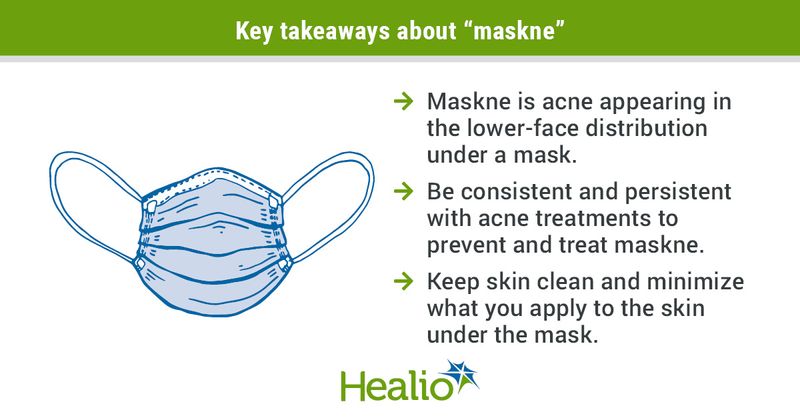Q&A: Treating ‘maskne’ in the COVID-19 era
Wearing a mask is now mandated in many public areas across the country in an attempt to stem the spread of COVID-19.
But while masks prevent droplets of saliva and some air particles from spreading, they also can cause some dermatological issues of the face.

Healio spoke with Julie C. Harper, MD, from the Dermatology and Skin Care Center of Birmingham in Alabama, about “maskne,” a newly reported problem that affects the area underneath the mask.
Q. What is “maskne?”
A. Maskne is real! It is something we are seeing in clinic, and the best way to describe it is acne that is coming up in the lower-face distribution under the mask. However, not all bumpy skin under the mask is acne.
When you see that bumpy acne-like skin, it could be one of three things. It could be true acne vulgaris, which is a common condition around the world, and it can be worsened in any area where there is moisture and occlusion. The second thing it could be is perioral dermatitis, which is characterized by fine tiny bumps around the nose and the mouth that look and feel like sandpaper. Thirdly, you might see a true infectious folliculitis, where you get some infection down in the pore itself. A simple worsening of acne is what I am seeing most often.

Q. What have you heard in terms of maskne?
A. No one likes to have acne, even acne under a mask. This is a frustrating problem, especially in individuals who have to wear a mask for prolonged periods of time. It can be painful and tender and is certainly unsightly.
Q. What about wearing a mask causes these issues?
A. We do not completely understand, but we do have other similar examples of acne worsening in a moist, occluded environment similar to the environment under a mask. One example is acne under a chin strap or a helmet. Acne in these areas can be difficult to treat and requires being very consistent with keeping the skin clean and using prescribed medications as directed.
Q. What can be done to prevent maskne?
A. I think the key is staying really consistent and persistent with your skin care routine and with you acne treatment regimen. Prevention is always better than spot treatment. There are many people who just spot treat acne bumps as they come up. If you only use acne medications to spot treat, you are missing out .The prescription medications that we have for acne certainly treat active acne bumps but they also help to maintain that improvement over time. If your acne is flaring up under the mask, keep treating the whole affected area. The goal is not to just get rid of the acne you have today, but to prevent next week’s acne or next month’s acne.
Of course, keep your skin clean and minimize what you apply to the skin right before applying the mask.
Keeping the skin clean, keeping the mask clean and changing the mask frequently are all things that can help prevent acne.
Q. What are the best treatments for maskne?
A. If we are talking about acne, whether it is maskne or acne that is not under the mask, it is important that we realize that we are talking about the same condition. So, we want to treat it the same.
The first thing I tell my patients is to continue to be consistent with the treatment regimen that they have. When we are treating acne, there are four targets we are trying to hit: the plugging of the follicle or the pore, inflammation, bacteria and, if we can, the oil gland. If your health care provider has recommended two or three different products to treat your acne, it is because they are trying to use a combination of products that hit as many of those four targets as they can.
Commonly, there would be a topical retinoid. A newer one we have out there now is called Aklief Cream 0.005% (trifarotene, Galderma). A topical retinoid is believed to be the cornerstone of treating acne. Other treatments can include benzoyl peroxide, a topical antibiotic, an oral antibiotic, or for some women a birth control pill or other hormonal treatments. If you have a regimen that is two or more products, do not go home and choose one of them. In particular with maskne, I would not want to see someone drop things out of their regimen. It is a time to be consistent with treatment.
One thing we should do differently, especially for those who are wearing masks for long periods of time, is to not put medications on directly before you apply the mask. In the sensitive area around the mouth, we do not want to push more of the product into the skin than we intend to. I would give yourself an hour or more before you put your mask on. Better yet, if you can, move most of your application of products to bedtime.
Q. When should someone contact a dermatologist?
A. Any time you are not managing acne well over the counter, feel free to call. I am always concerned that there is a group of people out there who think their acne is too mild to come and see me. Acne is never too mild to come see a dermatologist. If acne is bothering you, and you are not getting the success you want with over-the-counter treatment, we can direct the treatment more effectively and cost-effectively. Talk to your dermatologist to learn more about FDA-approved products to treat acne.

